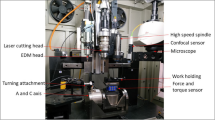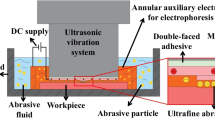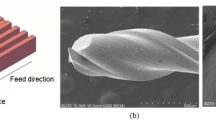Abstract
In the present paper, the process parameters of revolving tip-based machining were optimized for the fabrication of microchannel structures. It was found that in comparison with the micromilling process, the main factor affecting the surface quality of revolving tip-based machining originated from residual materials produced in each revolution. Three process parameters, including cutting depth, feeding rate, and tool path strategy, were studied experimentally to optimize the surface quality of the machined aluminum alloy and polymethylmethacrylate (PMMA). It was noticed that at smaller cutting depths (< 3 µm) and feeding rates (< 20 µm/s) with fixed revolving parameters (50 Hz frequency and 6 µm radius), microchannels with better bottom surfaces were formed. Two different types of tool path strategies were designed and compared to obtain the best surface quality (Sa) of aluminum alloy (21 nm) and PMMA (19 nm).












Similar content being viewed by others
References
Faustino V, Catarino SO, Lima R, Minas G (2016) Biomedical microfluidic devices by using low-cost fabrication techniques: a review. J Biomech 49(11):2280–2292
Prakash S, Kumar S (2015) Fabrication of microchannels: a review. Proc Inst Mech Eng Part B: J Eng Manuf 229(8):1273–1288
Dornfeld D, Min S, Takeuchi Y (2006) Recent advances in mechanical micromachining. CIRP Ann Manuf Technol 55(2):745–768
Guckenberger DJ, de Groot TE, Wan AM, Beebe DJ, Young EW (2015) Micromilling: a method for ultra-rapid prototyping of plastic microfluidic devices. Lab Chip 15(11):2364–2378
Gozen BA, Ozdoganlar OB (2010) A rotating-tip-based mechanical nano-manufacturing process: nanomilling. Nanoscale Res Lett 5(9):1403
Park S, Mostofa M, Park C, Mehrpouya M, Kim S (2014) Vibration assisted nano mechanical machining using AFM probe. CIRP Ann Manuf Technol 63(1):537–540
Heamawatanachai S, Bamberg E (2009) Design and characterization of a PZT driven micromachining tool based on single-point tool tip geometry. Precision Eng 33(4):387–394
Xue B, Yan Y, Li J, Yu B, Hu Z, Zhao X, Cai Q (2015) Study on the micro-machining process with a micro three-sided pyramidal tip and the circular machining trajectory. J Mater Process Technol 217:122–130
Yan Y, Xue B, Hu Z, Wu D (2016) Machining slight burr formed micro-channels with different moving trajectories of a pyramidal diamond tip. Int J Adv Manuf Technol 84(9–12):2037–2046
Ogilvie I, Sieben V, Floquet C, Zmijan R, Mowlem M, Morgan H (2010) Reduction of surface roughness for optical quality microfluidic devices in PMMA and COC. J Micromech Microeng 20(6):065016
Prentner S, Allen DM, Larcombe L, Marson S, Jenkins K, Saumer M (2010) Effects of channel surface finish on blood flow in microfluidic devices. Microsyst Technol 16(7):1091–1096
Huang Y, Liu S, Yang W, Yu C (2010) Surface roughness analysis and improvement of PMMA-based microfluidic chip chambers by CO2 laser cutting. Appl Surf Sci 256(6):1675–1678
Chen P-C, Pan C-W, Lee W-C, Li K-M (2014) An experimental study of micromilling parameters to manufacture microchannels on a PMMA substrate. Int J Adv Manuf Technol 71(9–12):1623–1630
Yousuff CM, Danish M, Ho ETW, Kamal Basha IH, Hamid NHB (2017) Study on the optimum cutting parameters of an aluminum mold for effective bonding strength of a PDMS microfluidic device. Micromachines 8(8):258
Lin T-Y, Do T, Kwon P, Lillehoj PB (2017) 3D printed metal molds for hot embossing plastic microfluidic devices. Lab Chip 17(2):241–247
Zhao DS, Roy B, McCormick MT, Kuhr WG, Brazill SA (2003) Rapid fabrication of a poly (dimethylsiloxane) microfluidic capillary gel electrophoresis system utilizing high precision machining. Lab Chip 3(2):93–99
Ayatollahi M, Aliha M, Hassani M (2006) Mixed mode brittle fracture in PMMA: an experimental study using SCB specimens. Mater Sci Eng, A 417(1–2):348–356
Xue B, Geng Y, Yan Y, Wang J, Sun Y (2018) Finite element analysis of revolving tip-based cutting process (submitted)
Zeng Q, Qin Y, Chang W, Luo X (2018) Correlating and evaluating the functionality-related properties with surface texture parameters and specific characteristics of machined components. Int J Mech Sci 149:62–72
Xue B, Geng Y, Yan Y, Sun Y (2018) Effect of AFM tip wear on evaluating the surface quality machined by ultraprecision machining process (submitted)
Xue B, Yan Y, Hu Z, Zhao X (2014) Study on effects of scan parameters on the image quality and tip wear in AFM tapping mode. Scanning: J Scanning Microsc 36(2):263–269
Poon CY, Bhushan B (1995) Comparison of surface roughness measurements by stylus profiler, AFM and non-contact optical profiler. Wear 190(1):76–88
Acknowledgements
The authors gratefully acknowledge the financial supports of the Foundation for the National Natural Science Foundation of China (51475108), Innovative Research Groups of the National Natural Science Foundation of China (51521003), Self-Planned Task (SKLRS201606B) of State Key Laboratory of Robotics and System (HIT), and the National Program for Support of Top-notch Young Professors.
Author information
Authors and Affiliations
Corresponding author
Rights and permissions
About this article
Cite this article
Xue, B., Geng, Y., Wang, D. et al. Improvement in Surface Quality of Microchannel Structures Fabricated by Revolving Tip-Based Machining. Nanomanuf Metrol 2, 26–35 (2019). https://doi.org/10.1007/s41871-018-0032-9
Received:
Revised:
Accepted:
Published:
Issue Date:
DOI: https://doi.org/10.1007/s41871-018-0032-9




